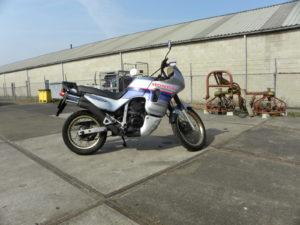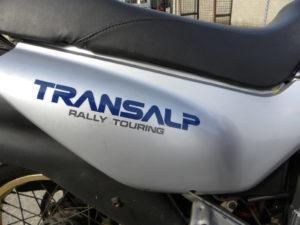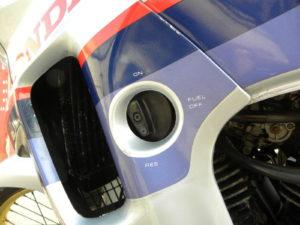The Honda Transalp is the handy cousin of the BMW GS. A friendly all-rounder who combines civilization and wanderlust with a certain sense of adventure.
The Honda Transalp was introduced in 1987
He was inspired by the Paris Dakar, but meant to be the ideal play bike for the Alps. The looks and the 21 inch front wheel were the tribute to the great off-road driving. But the Honda Transalp was born as a hairpin bend. The Honda Transalp remained unbeatable in the Ardennes, on the Lemeler mountain or among the pedal buckets in the Randstad traffic chaos. It is light, comfortable and manoeuvrable. In addition, the seating position gives you the ideal overview situation - that is, chances of survival - with an 'urban' deployment and traffic jams. Because let's face it: one of the great advantages of recent classics is that they can be used in the current traffic scene. On a youngtimer you can have fun every day instead of basking your pride under flannel sheets until all weather forecasters promise pure drought.
Suitable for pecking a stone chink
In connection with the comfortable suspension and damping of the twins, hard core off roaders spoke about 'Transzwalpjes'. Honda Transalps were indeed unsuitable for the heavier terrain work. The later versions from 650-700 cc are not very interesting in our story, but they are completely unsuitable for anything other than asphalt. A Honda Transalp is a slender high pot with a wide range of uses that proved ideal for local rambling, sensible but adventurous travel and for London motor couriers. And then you have a lot to do as a motorcycle. It is common knowledge that those London Kamikaze pilots do not have driving licenses, but have a weapons license. The lively, but thoroughly good 600 cc V-twin has the cylinders at an angle of 52 degrees. The crankshafts are at 76 degrees Each cylinder has - as was a trend at Honda - three valve per cylinder and an overhead camshaft and two spark plugs per cylinder.
The valves are simply operated with tumblers
That is a big plus for people who do their own maintenance. The mixture is supplied with 2 32 mm constant vacuum carburetors. The power is 50 (from 1989: 55 pk) at 8000 rpm. More than sufficient. As far as it is relevant: the top speed of the engine is approximately 150-160 km / h. But driving 120-130 is what he likes best. But with motorway use you do a Honda Transalp too short. After all, they were conceived for the Alps? From 1997 the Honda Transalps were made in Italy. And why is it not surprising that quality was affected in the beginning? There is a disc brake on the front. At the rear, the first generation Honda Transalps (up to 1991) has a drum brake. The 2000 cc version running up to 600 had a nice limited number of modifications. The switch from a drum to a rear disc brake in 1991 was the most visible.
In the current market the range of 600 cc Honda Transalps is large. They have been sales toppers and they are tough. The brave V-twins do the barrel under normal maintenance. A copy with 60.000 kilometers on the counter is therefore not necessarily a bad purchase.









